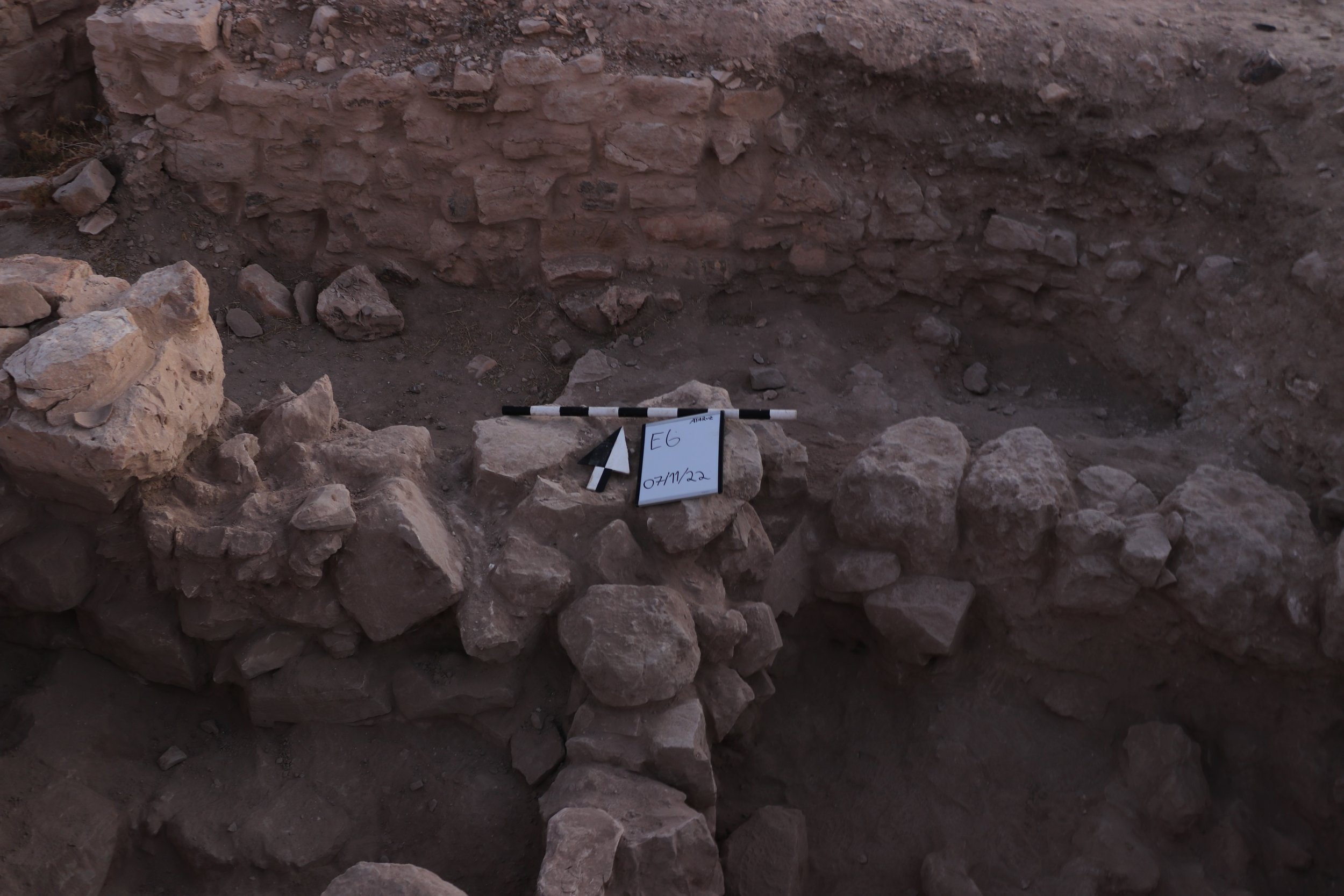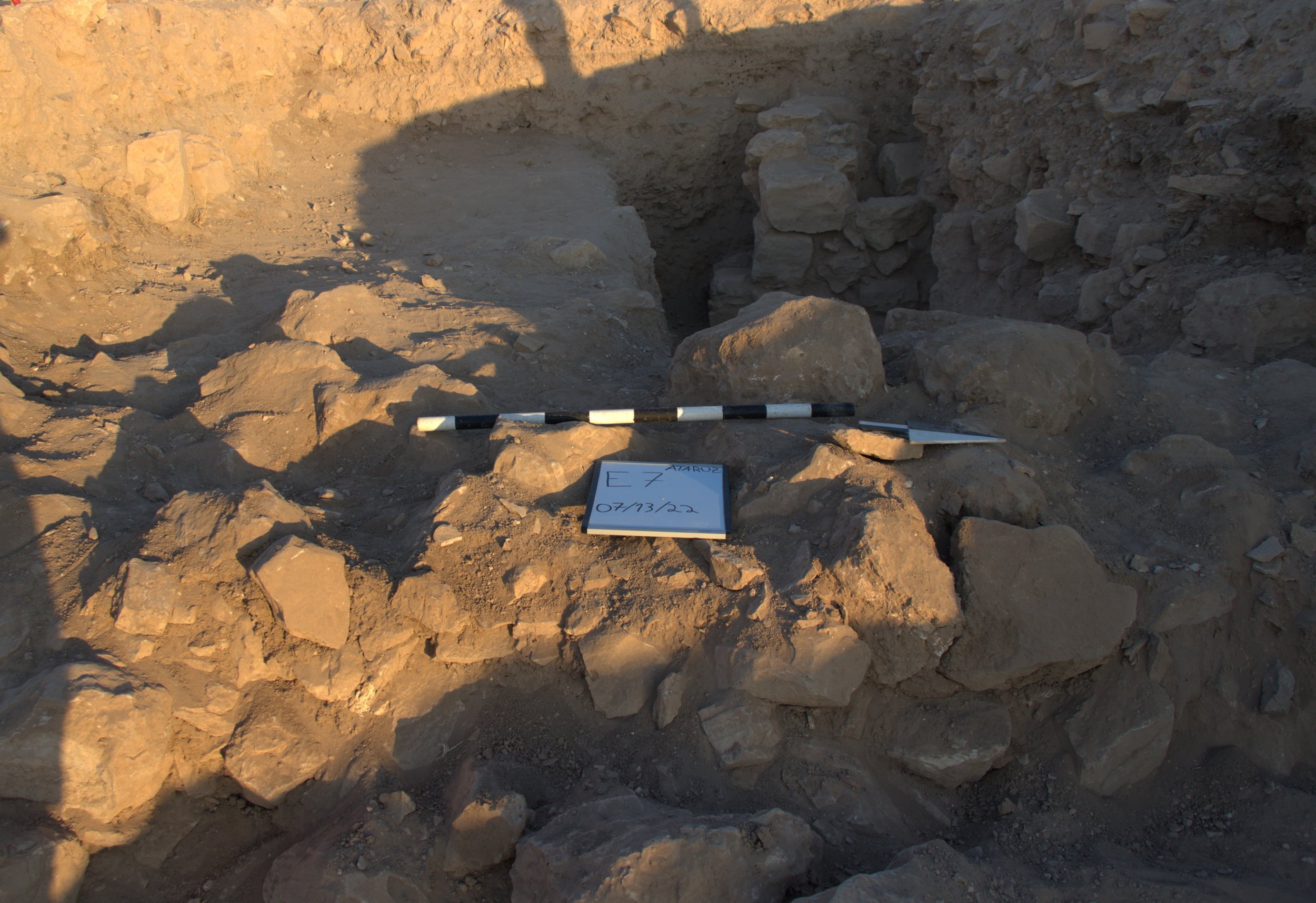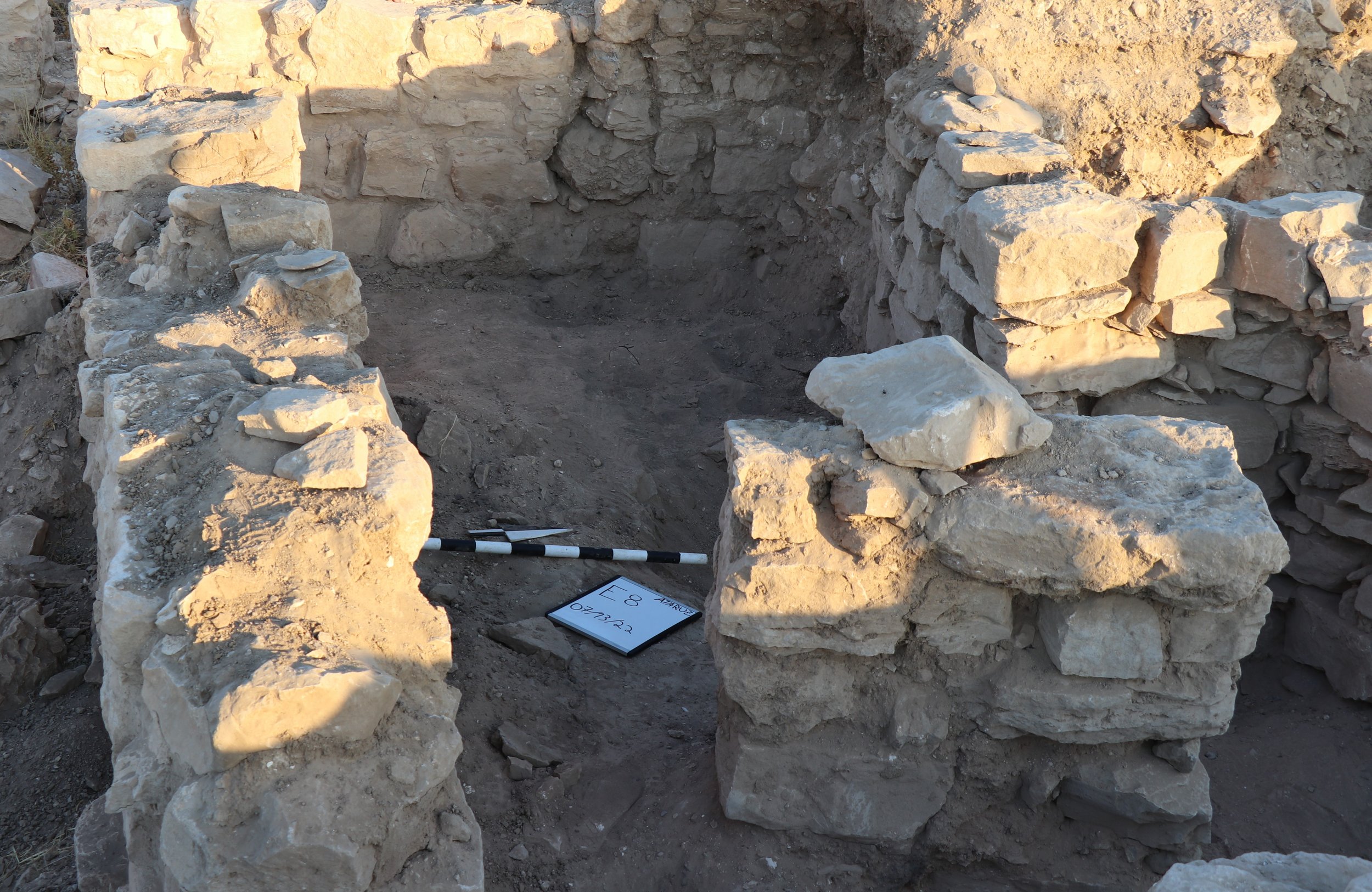The 2022 Khirbat Ataruz excavation occurred from June 23 to July 14, focusing on the east area of the acropolis (Field E) and its southeastern slope (Field G). Field G encompasses a possible monumental staircase or city access system that may have connected the temple at the acropolis to a potential city gate on the east side of the mound. The first section discusses the work undertaken in Field E, while the second section presents the findings from Field G.
Field E, Eastern Acropolis
Square E6 (2022)
During the 2022 field season, the team continued working in Squares E6 and E7 and opened a new 6 × 6 m square designated E8. In Square E6, previous excavations had revealed two wall lines (collectively called Wall E6:18) and, approximately two meters to the south, a rectangular stone installation measuring 1 × 2 m. The primary goal for 2022 was to investigate Wall E6:18 and Wall E7:10 further to clarify the relationship between Squares E6 and E7. Excavations began in the northeastern quarter of Square E6, where Wall E6:18 extends to the corner of the northern balk and rests directly on bedrock. Five layers of hard surfaces were identified here (Loci 34, 35, 36, 37, 38), including three nari floors (Loci 34, 35, 36), all dating to the Iron II period. Many animal bones, pottery sherds, and tabun (clay oven) fragments were also recovered.
Subsequent work shifted to the southern half of Square E6, where rock tumbles were discovered beneath Locus 40, extending to the bedrock. Two walls (Wall E6:48 and Wall E6:49) and a possible threshold installation (Installation E6:50) were revealed. Wall E6:48, measuring 1.8 m in length and 47 cm in width, runs northeast-southwest and abuts Wall E6:49, oriented east-west, and connects to a rectangular stone installation (Installation E6:10) near the western balk. Installation E6:50 (the threshold) is oriented southwest at a 70-degree angle, measures 2.1 m in length and 46 to 96 cm in width, and is located near the southern balk. After removing the northern balk between Squares E6 and E7, excavators recovered numerous pestles, two tabuns, and many pottery sherds from kraters and storage jars, all dating to the Iron IIA–IIB periods.
Square E7 (2022)
In Square E7, the team excavated roughly the northern half of the area, where Wall E7:10 was oriented to the northwest. Excavation of Locus 19 revealed another wall, E7:29, beneath Wall E7:10. Measuring 80–120 cm in width and standing 50 cm high. This underlying wall was built directly on the bedrock (Locus 27), suggesting that E7:10 may have been constructed atop E7:29. Five floor layers (Loci 18, 21, 22, 25, 27) were uncovered, including two nari floors (Loci 25, 27). A substantial quantity of bones and Iron IIA–Iron IIB pottery sherds, along with frequent tabun fragments, were found in Loci 22 and 25. The builders of the earlier floor used a combination of small and large stones and soil to create a compact surface above the bedrock.
Square E8, newly opened during the 2022 season, is located north of Square E6. Excavations uncovered five walls (E8:7, 13, 16, 30, 36), all built directly on bedrock. Wall E8:13, oriented northwest-southeast, measured 4 m long and 45–55 cm wide; it extended from the eastern balk to the corner of the northern balk and abuts Wall E8:7 to the south. Built of irregular boulders using the chinking method, Wall E8:7 was oriented south-north, measured 1.7 m long and 40–45 cm wide, and abuts Wall E8:16 to the west. Wall E8:16 has a 90-degree turn where it joins Wall E8:30, oriented west-east, and extends from the western balk at a length of 1.1 m and width of 40 cm. Inside Walls E8:16 and E8:30, the team found a cup-and-saucer, large amounts of pottery (including cooking pots, kraters, and storage jars) dating primarily to the Iron IIA–Iron IIB periods, and a few Islamic cooking pot fragments and a painted body sherd (Locus 4). Additional discoveries included numerous tabun fragments and pestles. Wall E8:36 was found at Locus 19 inside the eastern balk. Between Walls E8:7 and E8:36, excavators uncovered four floors or compact surfaces containing many pottery sherds, three in situ mortars, and many pestles and tabun fragments. All four walls (E8:7, 16, 30, and 36) incorporated several ashlar stones in their construction, and further study is required to determine their precise dates.
Northwestern Section of Square E6 (2022)
Excavating the Ash Bowl Installation after the E6/E8 Balk Removed
E6 and E8 Balk Removed
Results of Field G, Southeastern Slope
Square G11 (2022)
During the 2022 season, work in Field G focused on determining whether the stepped-stone stairs discovered in 2019 continued to the north and how they might relate to the architectural remains uncovered in Square G8 in the previous season. Since G8 contained an ashlar doorway extending into the northwest balk and a roughly north-south wall on the eastern side, the team sought to clarify its relationship to unexcavated areas to the north. Another goal was to connect Field G to Field E on the acropolis to the west. Four new squares, labeled G11–G14, were opened to that end. Square G11 was immediately north of G8, with two new squares to the east and another to the west, ascending toward Field E.
Following the initial cleanup in G11, excavations quickly revealed a possible wall (Locus 13), oriented roughly east-west and composed of large boulders and stones along the square’s northern side. Since a sequence of stairs had already been discovered elsewhere in Field G, the team hypothesized that this stone structure could be a continuation of those steps running westward toward the acropolis, or that it might function as a stabilizing “spine” for aligning additional stair rows. Progressing through the central part of G11, excavators encountered substantial rubble, larger stones, and significant damage. Changes in soil color and compaction appeared, and occasional flat stones emerged in a row-like pattern, although the extent of disturbance prevented a clear assessment of these features.
On the western side of G11, a second prominent stone feature (Locus 2) appeared, running roughly south–north and consisting of several courses of large boulders intersecting Locus 13 at the square's northwest corner. Given that its orientation was like other stair rows in Field G, the team considered this feature a potential component of the stepped sequence. The excavation also exposed multiple earth loci, where small cobbles and soil formed compact surfaces—techniques observed alongside rows of stairs elsewhere in Field G. Thus, the flat stones encountered amid the rubble may represent a continuation of the stepped-stone sequence leading up to the acropolis. Some of these stones lay sealed against Loci 2 and 13. Designated as Locus 14, this cluster of stones might be part of a stairway ascending westward toward the acropolis or a paved plaza composed of flat stones placed over compacted material. Locus 13 may have served as a stabilizing row for these stairs or a stone plaza. However, slight elevation changes and damage to the deposits suggest that a damaged stair sequence remains the primary working theory.
Below this installation, in multiple parts of the square, excavators identified compact surfaces composed of small- and medium-sized stones. The stones were arranged to support the flat stones above them, a building method confirmed by a series of probes on the southern edge of G11. Pottery in these lower loci was primarily Mid-Islamic in the south section of the square, with Iron Age II material predominating elsewhere, suggesting that multiple loci contributed to the flat stone construction.
To investigate the connection between G11 and G8 to the south, the team removed sections of the balk at the southern edge of G11. A three-locus probe was followed by excavating a one-meter section of balk down to the base of probe 3. In this area, excavators uncovered a reddish, lightly colored, and heavily compacted floor that appears to serve as the foundation for Locus 2. One explanation for Locus 2 is that it represents an elevated retaining wall built to support a flat-stoned plaza in the adjacent Square G12.
Square G12 (2022)
Square G12 is located at the westernmost edge of Field G, connecting with Field E. After cleaning the area, excavators uncovered significant stone features oriented roughly east-west along the square’s northern side (Locus 5). Although only partially visible, the stonework was substantial. As the team continued, they noted changes in soil color and identified multiple loci of compact earth, enabling a stratigraphic comparison with Field E. Within just a few centimeters of further excavation, numerous flat stones and a hard, compact floor were exposed. However, due to the extensive tumble, it was difficult to determine which stones were deliberately placed and which were displaced by erosion and collapse.
Despite the ambiguity, two roughly parallel sequences of wall-like structures, situated north and south of the square, became apparent; between them, excavators uncovered multiple large, flat stones resting on compact surfaces. As excavation proceeded, these flat stones appeared in rows like those observed in G11 and other parts of Field G. The team found no clear indication of rising elevation; the possibility remains that the flat stones formed a plaza reached by steps from G11. On the square's western side, additional rows of flat stones appeared to create a stair-like sequence leading toward the acropolis entrance and cultic center. However, rock tumbling and subsequent damage have established a definitive relationship between Field G and Field E complex.
Square G13 (2022)
Square G13 is located directly east of G11. After initial cleanup, the team discovered what may be a continuation of the flat-stone stair rows, oriented roughly north-south and closely resembling those found in G11, G12, and elsewhere in Field G. Only a tiny portion of these steps, set atop compacted earth, were uncovered; nevertheless, they display a similar arrangement to the rows previously documented in Field G. This pattern becomes more evident in G14 farther to the east, where additional stair segments are visibly preserved.
East of Square G13, excavations continued in Square G14 to trace additional rows of stairs. On the southeastern side of G14, three clear rows of stairs, oriented roughly north-south, were visible on the surface—like numerous other stair rows discovered throughout Field G, including those in G11–G13 to the north. These rows also appear to extend from Square G10, previously excavated in 2019, confirming that G14’s stepped-stone sequences comprise a stairway leading up the mound’s eastern slope toward the temple complex in the west. Squares G11–G14 exhibit a coherent system of ascent running east-west.
Square G14 (2022)
In summary, the 2022 season achieved several important objectives. Excavators identified a continuation of the stepped-stone sequences that ascended from the eastern slope to the acropolis, potentially confirming an east-west access route to the site’s temple complex. They also identified what may be a large retaining wall used to create a flat-stoned plaza near this route, suggesting a structural link between Fields E and G. Additionally, the initial investigation of G8’s relationship to G11 yielded clues that require further excavation to confirm the connection and the dating of the architectural features. Although many questions remain unresolved, these findings and working theories offer a clearer picture of Ataruz’s layout and bring the project closer to understanding this ancient site.
Ground Penetrating Radar Project
Ground Penetrating Radar (GPR) enables archaeologists to survey sites for potentially buried structures, detect soil anomalies, and identify risks of damage before excavations begin. This non-invasive approach helps ensure efficient and safer digs by reducing the need for extensive preliminary trenching.
In 2022, John McBride joined the Ataruz excavation team to conduct GPR surveys in three areas: the northern portion of Field E (6 × 12 m), a large natural terrace on the southeastern corner of the site (6 × 12 m), and along the southern defense wall lines west of Field B. The GPR data is expected to reveal outlines of possible underground buildings and other features, helping the team decide where future excavations should focus. After returning to the United States, Dr. McBride will process the data, generate detailed images, and provide recommendations for subsequent fieldwork.
Conclusion and Future Plans
Based on the 2022 excavations, the architectural remains in Squares E6, E7, and E8 likely date to the 9th – 8th centuries BCE, forming part of an Iron II settlement on the acropolis. Many Iron II structures appear contemporaneous with the 9th-century BCE temple. The staircase and city access system in Field G also seem to date mainly to the Iron IIA–IIB period, except for the southern area of Square G11, which yielded some Mid-Islamic pottery sherds. Taken together, the results from G11 through G14 support the existence of a formal stairway leading from the base of the southeastern slope up to the temple complex on the acropolis. Ongoing excavations will connect this corridor to the large rectangular structure assumed to be the Iron II city’s entrance system.
As in previous seasons, walls and installations uncovered during the 2022 campaign were temporarily reinforced with cement for protection, pending a broader conservation plan. The project team intends to return to Khirbat Ataruz in 2023 to continue work in Fields E and G, further investigating these significant Iron II architectural remains and their broader implications for the site’s history.









